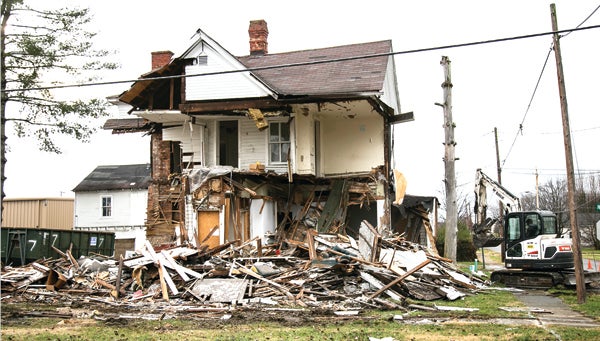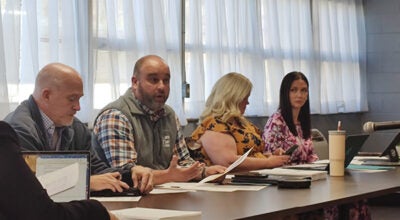Structure had rich history but never recovered from Depression
Published 9:03 am Monday, December 8, 2014

Photo by Brandon Hicks
A demolition crew has been busy the past couple of days razing the old D.E. Taylor at the corner of Sycamore Street and Cottage Avenue. The house was built in the 1890s, making it close to 125 years old.
Houses are much like people. They have a beginning and an ending. It is the years in between that make it an interesting subject.
Demolition began last week on an old house that has been a landmark for more than 100 years at the corner of Sycamore Street and Cottage Avenue. The house, which the City of Elizabethton condemned a couple of years ago, had a rich but troubled history. Sadly, it could never recover from the hard times of the Depression era. Its glory days never could be reclaimed, even though many of its 20th-century owners tried.
The property is presently owned by Debra L. Elliott, who also owns property at 507 N. Sycamore St. adjacent to the old house on Sycamore Street. She purchased the property for $30,000 in September 2012 from David I. and Kim Campbell, who received the property in 2007 from his mother, Gearlean Campbell, and her grandson Jamie Miller through a quitclaim deed.
The house dates back to before 1898, when D.E. Taylor and his wife, Jennie, sold the property to L.W. Rhudy for $450. The Taylors and Rhudys were owners and operators of the Doe River Overall Factory, which was across the street from the house. Rhudy and his wife, Carrie, sold the house and the two lots back to the Taylors in January 1907 for $1,000.
Virginia Laws, a granddaughter of the Taylors, said she was born in the house in 1920 when her parents, Burchell and Carrie Taylor lived there for a short time with his parents.
The property had been purchased from the Cooperative Town Co., which was organized in 1891 with the purpose of building a town on the west side of the Doe River.
Ten years later, the Town Cooperative Co. was placed into receivership, and thus, the organized efforts to build a city in which so many prominent people had been involved came to an end. The 1890s and early 1900s were glory days for the town and the old house on Sycamore Street.
An elegant Victorian house, it featured a large wraparound porch and an upstairs balcony on the front. Four large fireplaces downstairs heated the home. The exterior of the house originally featured gingerbread trim that in later years was covered with vinyl siding.
A member of the demolition crew called attention to the amount of lumber in the house, noting it was a well-built and -designed structure.
In earlier years, the house featured a beautiful front door with beveled glass and a baluster staircase. The house was designed in an era when Elizabethton was a mecca of social activity and was booming with small businesses and industries.
The Taylors and the house fell on hard times during the Great Depression of the late 1920s and early 1930s. The house was foreclosed on in 1928 and placed in receivership with Alexander Parker and Ben Allen named as trustees. The Taylors had borrowed money on the house and owed $3,500 on a promissory note payable to the First And Merchants National Bank of Richmond, Va.
Mrs. Laws recalls that her grandparents moved to Carter County from Southwest Virginia and were closely related to the Dungan and Rhudy families.
“My grandfather when he first came to the area worked at the Dungan Mill in Hunter,” she said.
Like many other investors in the town, including the Dungans and Rhudys, the Taylors went through some hard times during Depression. Most had invested what they had into the town and lost their holdings.
The house and lots were purchased out of receivership by J.W. Holtsclaw and wife, who in October 1932 sold the property to M.C. Bowers, who agreed to pay off the debt tied to the house and property. The debt included a loan secured by a deed of trust to the Bank of Louisville, Ky., as well as the balance of two notes.
Another deed shows that in August 1941, Joseph B. Wallace owned the property and for the second time, the property was foreclosed on and sold at public auction. W.G. Hazelwood and his wife, M.N. Hazelwood, purchased the property, agreeing to assume payment of the debt on the house and property, which dated backed to 1932 and before.
Other owners of the house have included A.B. Carrico and his heirs, who later sold the property to Edgar E. Smith and his wife, Hazel, for $15,900.
In September 1996, John T. Stevens and his wife, Barbara, sold the property to Charles L. Elbell and his wife, Marie.
Gearlean Campbell and Jamie Miller bought the house at public auction in 1999.
In later years, the house was used as a boarding house, and rooms were rented out. After that, it fell into a state of disrepair, resulting in its condemnation.
Long gone were the days when the house enjoyed such gentle customs as afternoon teas, visits from fascinating people and the graceful memories of an era when ladies’ silken skirts whispered as they walked, and couples courted on porch swings.
Yes, like people, old houses usually know both good times and bad times. They have a story to tell, as do the people who have lived there.





